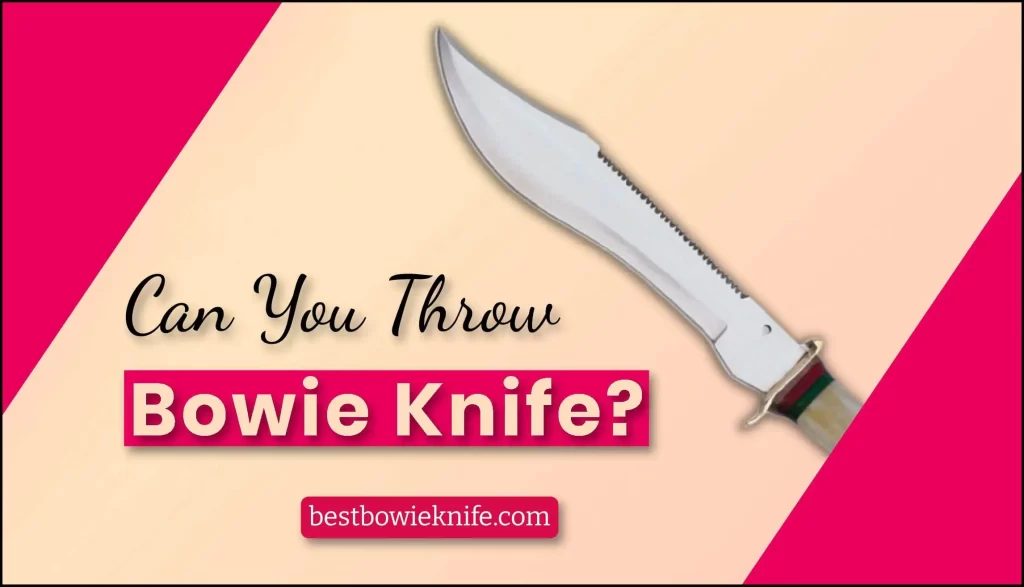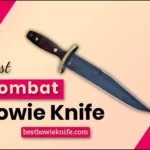If you have the best Bowie knife and want to know how to throw such knives then this guide is very useful and informational for you.
How to throw a Bowie Knife?
Throwing knives have been around almost since the invention of the first knife. As a result, the types and styles of knives designed for throwing have evolved throughout the years.
There are some surprising knives that can be thrown accurately if you know how to do so. But the question that arises here is can you throw a bowie knife?
The bowie knives are powerful weapons, and it is not recommended to throw them without knowing the exact ways.
First of all, you have to know that throwing a knife needs practice and learning methods. Without learning how to throw a bowie knife, you may harm yourself or another one.
Bowie knives are not like other common knives, they are slightly larger than others. and are originally made for combat. Now people used these for many purposes like hunting, defense, etc. These knives are not good for throwing.
In favor of the blade, the weight distribution is lopsided. The weight of the blade is more than the weight of the handle. That’s why the users of bowie knives often utilize small knives for throwing.
There are some easy steps for throwing a knife and everyone can learn easily by following these steps.
6 Steps to Throw a Bowie Knife
You can get the best results when throwing a bowie knife by following these six steps:
1. Choosing a Specific Practice Area:
Designate a safe practice area for practicing how to throw a bowie knife. Throwing a knife at a grocery, or populated place may harm someone.
You have to choose a proper place for learning and practicing throwing knives. In this way, you will protect yourself and others from danger in the event of missed or stray knife throw.
2. Setting Target Distance:
It is best to set your target approximately 10 paces away from your position during the practice of throwing a bowie knife.
Mark a line on the place from where you will throw your knife. You can use your foot, knife, or any other tool which is available alternatively.
3. Understanding Balance:
Compared to other traditional knives they do not have the same balance. must become familiar with their balance. You can find it by extending your two fingers and placing the knife on them.
You should slide the flat of the knife’s blade up and down along your fingers until you locate the most balanced position of the knife.
It is important to ensure that both the knife handle as well as the blade edge are resting evenly and horizontally on your fingers.
4. Facing Target:
Standing in front of the target, grasp the Bowie’s handle with your thumb, pointer finger, and middle finger using your dominant hand. Place the two remaining fingers (the ring finger and pinky) on the handle gently.
Check your grip by practicing throwing and cutting while holding your knife gently. Make sure that the knife blade is not threatened to become loose and wobble.
If this occurs then realign your fingers in a way that the palm of your hand and your bowie knife handle become in touch.
5. Executing Throw:
Point the knife blade towards the target and extend forward your throwing hand. Then draw your arm back and point your elbow straight upward at the same level as your head.
Immediately after starting your hand’s downward curve in the arc, snap the throwing arm forward quickly in an even, smooth arc, releasing the handle at that exact moment.
6. Practicing Regularly:
Follow the previous steps and repeat them again and again until you are able to consistently hit the target. As they say: “practice makes perfect” It is important to practice regularly even if you already know the correct technique to improve your accuracy.
Practicing how to throw a bowie knife is not easy as compared to learning and practicing the throwing of a traditional knife. However, it is possible to achieve this goal by regularly practicing and managing the balance of your bowie knife.
Final Verdict
Once you master the proper technique, you will be able to throw a Bowie with the same facility as a smaller and li traditional knife.


![Best Bowie Knife Reviews 2024 | Guide for Everyone [Top 20 Products] Best Bowie Knife Reviews 2024 | Guide for Everyone [Top 20 Products]](https://m.media-amazon.com/images/I/31hfV62McQL._AC_.jpg)



